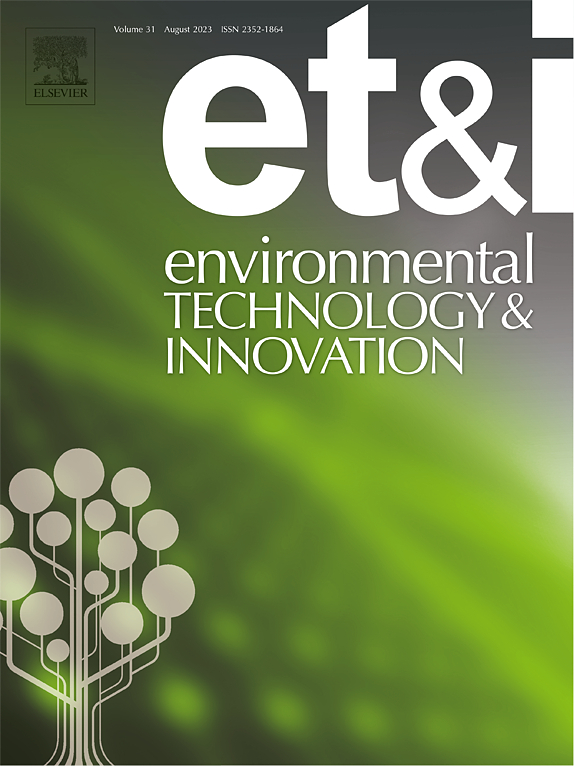Effect of vermiculite on in-situ super-stable mineralization and amelioration on sodic soil
IF 6.7
2区 环境科学与生态学
Q1 BIOTECHNOLOGY & APPLIED MICROBIOLOGY
引用次数: 0
Abstract
As a non-traditional cultivated land resource that can be reformed, sodic soil after amelioration can be effectively utilized to alleviate the food crisis. It is crucial to develop a new strategy that is efficient, cost-effective, and environmentally friendly for sodic soil remediation. Vermiculite features a high cation exchange capacity and porous structure. By adding Mg2+-intercalated vermiculite (VMT) and Al2(SO4)3 into the sodic soil, detailed quasi-in-situ X-ray diffraction and transmission electron microscope demonstrated the mineralization process. The free OH–, CO32– and Cl– can be in-situ super-stable mineralized into MgAl-layered double hydroxide (MgAl-LDH). The CO32– and Cl– were confined in the interlayer of MgAl-LDH, while OH– reacted with Mg2+ and Al3+ to form the laminate of MgAl-LDH. At the same time, due to slow release of Mg2+ from VMT, the cationic vacancy can be formed, which can be filled by large amounts of soluble Na+ in sodic soil in order to balance the charge. Sodic soil amelioration experiments illustrated that after remediating sodic soil with 2.0 wt% (weight percentage) VMT and Al2(SO4)3 for 150 days, the soil pH decreased from 10.18 to 7.47, while the contents of soluble Na+ and CO32– reduced significantly. Moreover, seedling emergence rate of corn and cabbage plants after application of VMT and Al2(SO4)3 of sodic soil increased from 6.3% to 87.5% and 2.5% to 84.1%, respectively. Compared to traditional methods, this method reduced water usage and offered advantages including high mineralization capacity, excellent stability, and fast rate. This work provides deep insight into in-situ super-stable mineralization for sodic soil amelioration using VMT.
蛭石对盐渍土原位超稳定矿化及改良的影响
改良后的碱土作为一种可以改造的非传统耕地资源,可以有效地利用来缓解粮食危机。开发一种高效、经济、环保的碱土修复新策略至关重要。蛭石具有较高的阳离子交换能力和多孔结构。通过在盐渍土中添加Mg2+插层蛭石(VMT)和Al2(SO4)3,通过准原位x射线衍射和透射电镜对矿化过程进行了详细的表征。游离的OH -、CO32 -和Cl -可以被原位超稳定矿化成mgal层状双氢氧化物(MgAl-LDH)。CO32 -和Cl -被限制在MgAl-LDH层间,OH -与Mg2+和Al3+反应形成MgAl-LDH层。同时,由于VMT缓慢释放Mg2+,形成阳离子空位,可由大量可溶性Na+在碱土中填充,以平衡电荷。钠土改良试验表明,以2.0 wt%(重量百分比)VMT和Al2(SO4)3修复钠土150 d后,土壤pH由10.18降至7.47,可溶性Na+和CO32 -含量显著降低。施用VMT和Al2(SO4)3后,玉米和白菜幼苗出苗率分别由6.3%提高到87.5%和2.5%提高到84.1%。与传统方法相比,该方法减少了用水量,具有矿化能力高、稳定性好、速率快等优点。本研究为原位超稳定矿化应用于VMT改良碱土提供了深入的见解。
本文章由计算机程序翻译,如有差异,请以英文原文为准。
求助全文
约1分钟内获得全文
求助全文
来源期刊

Environmental Technology & Innovation
Environmental Science-General Environmental Science
CiteScore
14.00
自引率
4.20%
发文量
435
审稿时长
74 days
期刊介绍:
Environmental Technology & Innovation adopts a challenge-oriented approach to solutions by integrating natural sciences to promote a sustainable future. The journal aims to foster the creation and development of innovative products, technologies, and ideas that enhance the environment, with impacts across soil, air, water, and food in rural and urban areas.
As a platform for disseminating scientific evidence for environmental protection and sustainable development, the journal emphasizes fundamental science, methodologies, tools, techniques, and policy considerations. It emphasizes the importance of science and technology in environmental benefits, including smarter, cleaner technologies for environmental protection, more efficient resource processing methods, and the evidence supporting their effectiveness.
 求助内容:
求助内容: 应助结果提醒方式:
应助结果提醒方式:


